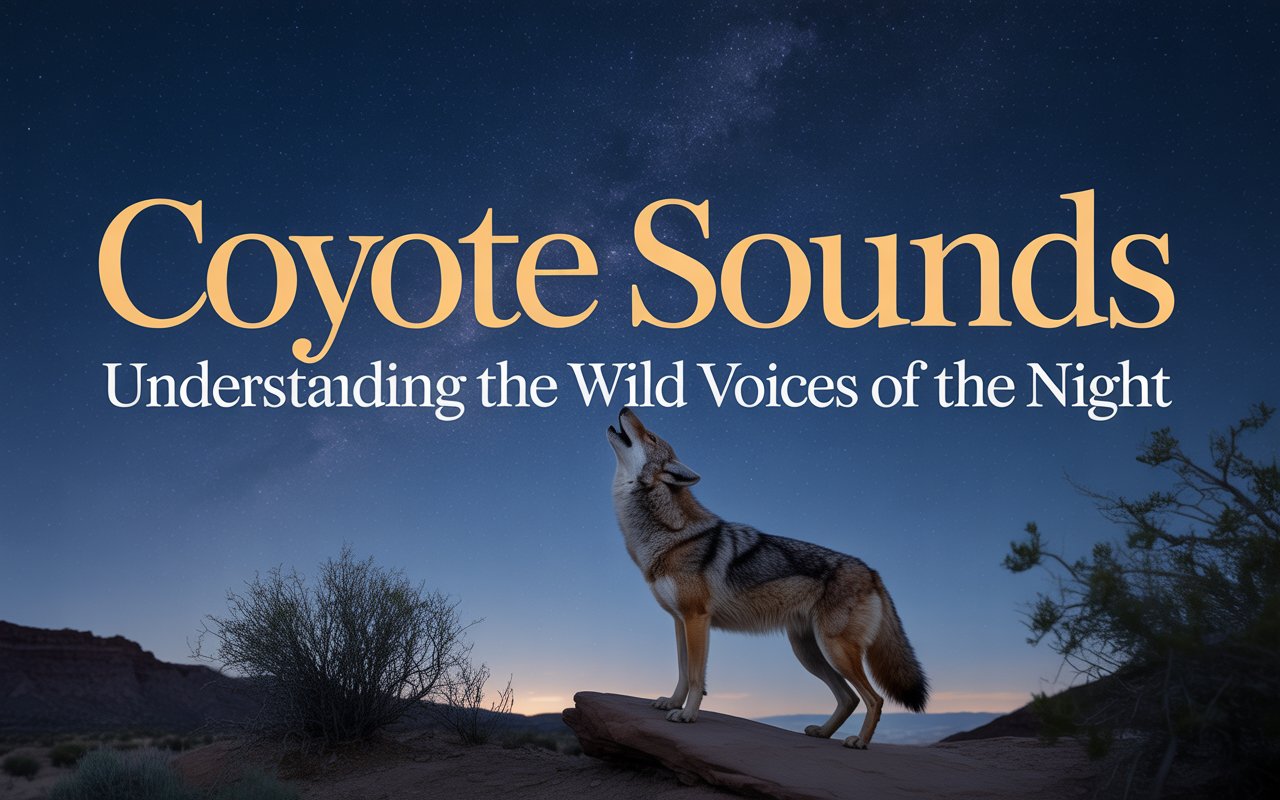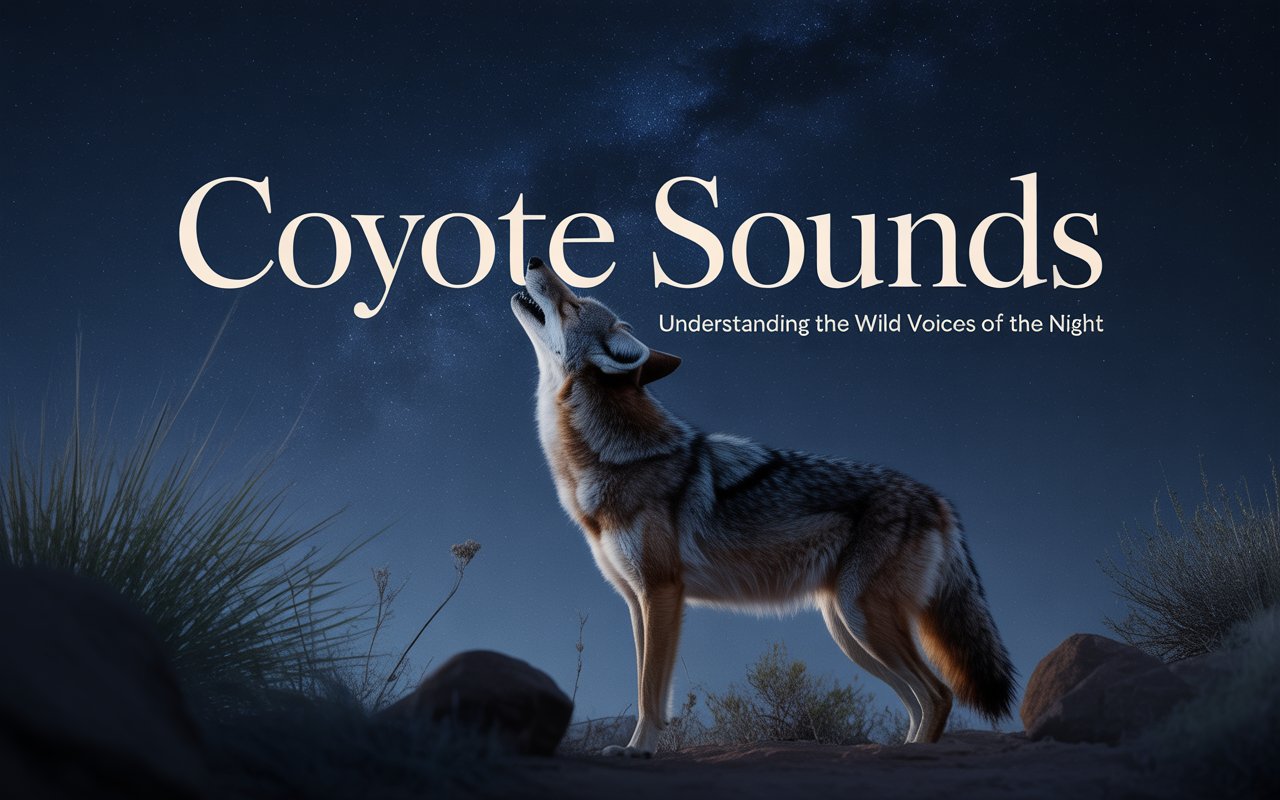If you’ve ever heard eerie howls echoing through the night and wondered, “What was that?“— chances are, that haunting melody came from a coyote announcing its presence to the night These mysterious calls of the wild can stir curiosity, awe, or even fear. But what do those sounds really mean? Are the coyotes warning others, calling for mates, or celebrating a meal?
In this comprehensive guide, we’ll dive deep into coyote sounds — decoding their howls, yips, and growls — to help you understand what these intelligent animals are really saying. You’ll discover not only what each sound means but also why coyotes vocalize so much, how they communicate within their packs, and what to do if you hear them near your home.
Let’s tune into the wild and decode nature’s language together.
1. The Language of Coyotes: A Symphony of the Wild
Unlike wolves, who primarily howl in long, drawn-out tones, coyotes mix things up — howls, barks, whines, and high-pitched yips all blend together in their nightly symphony. Their vocalizations aren’t just noise; they serve very real purposes.
Coyotes use their voices to:
-
Signal territory boundaries
-
Locate family members
-
Warn of potential threats
-
Coordinate hunting or movements
-
Strengthen pack bonds
It’s like they have their own social media network — but instead of Wi-Fi, it’s powered by sound waves.
2. Why Do Coyotes Howl?
The howl is the most iconic coyote sound. It’s haunting, melodic, and can travel up to several miles depending on the terrain and weather. But why do they howl in the first place?
Coyotes howl mainly for communication and coordination. When one coyote howls, it might be:
-
Marking territory: Declaring ownership of a particular area.
-
Locating the pack: “Where are you?” — a long-distance call to find family members.
-
Celebrating a reunion: After being separated, coyotes may howl together to strengthen social bonds.
-
Warning others: A coyote may howl to deter rivals or alert the pack about danger.
Interestingly, a single coyote can sound like several when howling due to the way sound echoes and bounces — a trick of nature that makes small packs seem much larger.
3. The Yips, Yaps, and Yowls: Breaking Down Coyote Calls

Coyotes don’t just howl — they have a whole vocabulary of sounds that they mix and match depending on the situation.
a. Yips and Yaps
These short, sharp sounds often happen in groups or family gatherings. Yips express excitement or playful energy, especially after a successful hunt. It’s almost like the coyotes are celebrating with high-fives — their own wild version of “woo-hoo!”
b. Growls and Snarls
These low, guttural sounds signal aggression or defense. Coyotes use them to warn intruders or establish dominance within their group. Think of them as verbal “back off” messages.
c. Whines
Whining usually comes from pups or submissive adults. It’s a way of asking for attention or food — similar to a dog’s whimper when it wants affection.
d. Barks
Coyotes bark as alarm calls when they detect potential danger. One sharp bark can alert the pack or ward off threats. Unlike domestic dogs, coyote barks are shorter and more urgent.
e. The Group Yip-Howl
Perhaps the most recognizable coyote chorus — a mix of howls, barks, and yips. It often happens at dawn or dusk and can sound like a dozen animals even if only a few are present.
4. When Do Coyotes Make Noise?
Coyotes are crepuscular, meaning they’re most active at dawn and dusk. Their peak vocal times correspond to when they hunt or move between territories.
You might hear them:
-
Early evening: Announcing their nightly activity.
-
Midnight: Reuniting or responding to distant howls.
-
Early morning: Wrapping up the night’s events.
In spring, when pups are born, vocal activity increases. Parents howl and yip to protect and communicate with their young.
5. The Science Behind Coyote Communication
Researchers studying coyote behavior have found that vocalizations aren’t random — they’re structured. Each coyote’s call carries information about its age, sex, and emotional state.
Territorial Messages
Howls can signal “this land is taken.” By broadcasting their presence, coyotes avoid direct confrontations, saving energy and reducing injury risks.
Pack Coordination
Coyotes hunting as a group use short-range barks and whines to coordinate movements. It’s their version of teamwork chatter.
Social Bonds
Group howling strengthens family ties. It’s less about territory and more about unity — a way to say, “We’re together.”
6. Coyotes vs. Wolves and Dogs: Spotting the Difference in Sounds

If you’re unsure whether you’re hearing coyotes or wolves, you’re not alone — many people mistake one for the other.
| Feature | Coyotes | Wolves | Domestic Dogs |
|---|---|---|---|
| Tone | High-pitched, variable | Deep, steady | Wide range depending on breed |
| Pattern | Fast, mixed sounds | Long, drawn-out howls | Often repetitive barking |
| Duration | Short bursts | Sustained howls | Short or continuous barking |
| Impression | Many animals | One or few | Familiar dog-like tone |
Coyotes often sound like a crowd — but don’t be fooled. It’s usually just two or three individuals harmonizing.
7. What Coyotes Are Saying to You (and Each Other)
Coyotes don’t howl at people directly, but their calls might have messages that we can interpret.
-
If you hear a lone howl: It’s likely a coyote locating its pack.
-
If it’s followed by many yips: They’ve reunited — that’s joy you’re hearing.
-
If the howling stops suddenly: They might have detected danger or gone silent to listen.
Their communication system is so efficient that coyotes can adjust their vocal tone to sound farther or closer, depending on the message they want to send.
8. Are Coyote Sounds Dangerous?
Hearing coyotes nearby might make some people uneasy, especially at night. But in most cases, it’s harmless. Coyotes are naturally cautious of humans and prefer to keep their distance.
However, take caution if:
-
You notice frequent howling near your home (possible den site).
-
You hear aggressive barking or snarling near pets.
-
Coyotes seem active during daytime (which could indicate illness or hunger).
For the most part, their calls are simply part of nature’s soundtrack — not a threat.
9. How to Respond if You Hear Coyotes Near Your Home

If you live near rural or suburban areas, coyote sounds might be common. Here’s how to stay safe and respectful:
-
Don’t panic. Howling doesn’t mean they’re coming for you — it’s just communication.
-
Keep pets indoors at night. Coyotes may see small pets as prey.
-
Secure garbage and food sources. Avoid attracting them.
-
Use noise deterrents. Motion lights, whistles, or banging pans can scare them away.
-
Avoid feeding them. This reduces their natural fear of humans.
Remember: coexistence works best when we understand rather than fear wildlife.
10. Cultural and Symbolic Meaning of Coyote Sounds
Across cultures, the coyote has been seen as a trickster, teacher, and messenger. Native American legends often portray the coyote as a symbol of cleverness, adaptability, and resilience.
Hearing a coyote’s howl was sometimes viewed as a spiritual message — a reminder of nature’s power, the balance between chaos and harmony, or even a sign to trust one’s instincts.
Even today, many people find something deeply moving in that wild cry — a reminder that, despite our cities and screens, the wilderness still sings around us.
11. The Urban Coyote: Adapting to the Modern World
Coyotes aren’t just creatures of the forest anymore. They’ve adapted astonishingly well to suburban and even urban environments. From Los Angeles to Chicago, these resilient animals thrive alongside humans.
And yes, they still howl — even amidst traffic and city noise. Their adaptability in both environment and communication makes them one of the most successful predators in North America.
They’ve learned to modify their calls to suit urban life — shorter, quieter howls that travel through city spaces without attracting too much attention.
12. The Mystery of the Midnight Chorus
If you’ve ever stood outside under a moonlit sky and heard a chorus of coyotes, you know it’s unforgettable. Some describe it as chilling; others find it strangely beautiful.
That chorus is more than random noise — it’s a social event. Coyotes are reaffirming bonds, celebrating survival, or simply sharing their presence.
It’s nature’s version of a choir — a wild, echoing harmony that reminds us we share this planet with creatures who have their own languages, emotions, and families.
Conclusion: Listening to the Wild
Coyote sounds are more than eerie echoes in the dark — they’re the soundtrack of survival, communication, and kinship. From their sharp yips to their haunting howls, every sound carries meaning and purpose.
When you next hear them, pause and listen. You might just catch a glimpse into a parallel world — one where communication flows not through words, but through sound, instinct, and emotion.
Coyotes remind us that nature still speaks — if only we’re willing to listen.
FAQs About Coyote Sounds
1. Why do coyotes howl at night?
Coyotes howl at night mainly to locate their pack, mark their territory, and communicate with other coyotes. Nighttime is quieter, making it easier for their calls to travel long distances.
2. Are coyotes more active during certain seasons?
Yes. Coyotes are especially vocal in spring when protecting pups and in fall during mating season. These periods require more communication within and between packs.
3. Can a single coyote sound like a whole pack?
Absolutely. A single coyote’s voice can echo and create the illusion of multiple animals due to its varied pitch and tone — a clever survival adaptation.
4. Should I be worried if I hear coyotes near my house?
Not necessarily. Hearing coyotes doesn’t mean danger. However, you should keep pets secure and avoid leaving food outdoors to discourage their visits.
5. What should I do if coyotes seem aggressive?
If a coyote approaches or behaves aggressively, make loud noises, wave your arms, and maintain eye contact. Never run — instead, back away slowly and make yourself appear larger.













